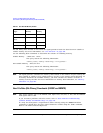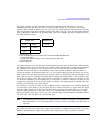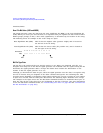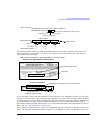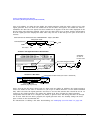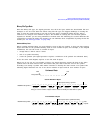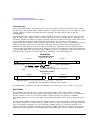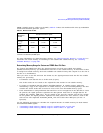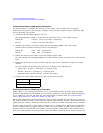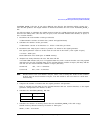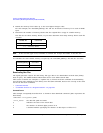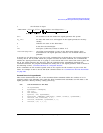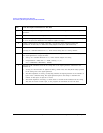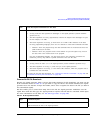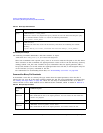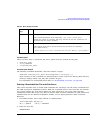
294 Agilent N518xA, E8663B, E44x8C, and E82x7D Signal Generators Programming Guide
Creating and Downloading User-Data Files
User File Data (Bit/Binary) Downloads (E4438C and E8267D)
Calculating Volatile Memory (PRAM) Usage for Unframed Data
Use this procedure to calculate the memory size for either a bit or binary file. To properly
demonstrate this process, the procedure employs a user file that contains 70 bytes (560 bits), with
the bit file using only 557 bits.
1. Determine the AUTOGEN_PRAM_1 file size:
The signal generator creates a 32-bit word for each user file bit (1 bit equals 4 bytes).
Binary file 4 bytes × (70 bytes x 8 bits) = 2240 bytes
Bit file 4 bytes × 557 bits= 2228 bytes
2. Calculate the number of memory blocks that the AUTOGEN_PRAM_1 file will occupy:
Volatile memory allocates memory in blocks of 1024 bytes.
Binary file 2240 / 1024 = 2.188 blocks
Bit file 2228 / 1024 = 2.176 blocks
3. Round the memory block value to the next highest integer value.
For this example, the AUTOGEN_PRAM_1 file will use three blocks of memory for a total of 3072
bytes.
4. Determine the number of memory blocks that the copy of the original file occupies in volatile
memory.
For this example the bit and binary file sizes are shown in the following list:
• Binary file = 70 bytes < 1024 bytes = 1 memory block
• Bit file = 80 bytes < 1024 bytes = 1 memory block
Remember that a bit file includes a 10-byte file header.
5. Calculate the total volatile memory occupied by the user file data:
Calculating Volatile Memory (PRAM) Usage for Framed Data
Framed data is not a selection for Custom, but it is for TDMA formats. To frame data, the signal
generator adds framing overhead data such as tail bits, guard bits, and sync bits. These framing bits
are in addition to the user file data. For more information on framed data, see “Understanding
Framed Transmission For Real-Time TDMA” on page 304.
When using framed data, the signal generator views the data (framing and user file bits) in terms of
the number of bits per frame, even if only one timeslot within a frame is active. This means that the
signal generator creates a 32-bit word for each bit in a frame, for both active and inactive timeslots.
You can create a user file so that it fills a timeslot once or multiple times. When the user file fills a
timeslot multiple times, the signal generator creates the same number of frames as the number of
timeslots that the user file fills. For example, if a file contains enough data to fill a timeslot three
times, the signal produces three new frames before the frames repeat. Each new frame increases the
AUTOGEN_PRAM_1 Original File
3 blocks 1 block
1024 (3 + 1) = 4096 bytes



